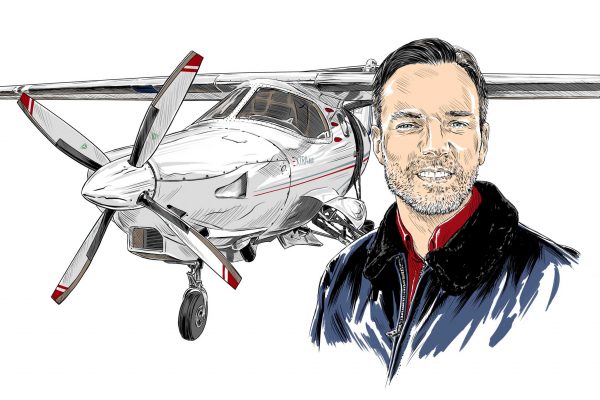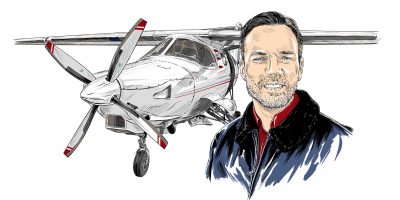How do pilots define night in the UK?
The ICAO definition of night is ‘the hours between the end of evening civil twilight and the beginning of morning civil twilight or such other period between sunset and sunrise, as may be prescribed by the appropriate authority’. Civil twilight ends in the evening when the centre of the sun’s disc is 6° below the horizon and begins in the morning when the centre of the sun’s disc is 6° below the horizon.
The length of time it takes for the sun to move through those six degrees varies with latitude and season. For example, at the equator it is about 23 minutes, but in the north of Scotland during the summer, it would be closer to an hour.
Note that two definitions of night appear in UK law – the UK Standardised Rules of the Air (UK SERA) contains the ICAO definition linked to civil twilight, but the Air Navigation Order 2016 and UK Aircrew Regulation use half-an-hour after sunset and half-an-hour before sunrise. For the purposes of determining when a night rating is required, the latter definition would apply. For requirements contained in the Rules of the Air, for example when navigation lights need to be switched on, the ICAO definition applies.
Can you fly VFR at night?
Prior to the adoption of the Standardised European Rules of the Air (SERA) in 2014, all night flights in the UK had to comply with the Instrument Flight Rules (IFR). This meant remaining more than 1,000ft above the highest obstacle within 5nm of the aircraft, except for when taking off or landing. The only exception to this was if flying in sight of the surface when at or below 3,000ft amsl, you could still be compliant with the IFR, without needing to comply with the 1,000ft agl requirement. Previously PPL holders without an instrument qualification could fly in accordance with the IFR, but you had to observe the licence visibility minima, including always being in sight of the surface.
SERA changed the ruleset – an instrument qualification was now required to fly under IFR, and the PPL privileges were aligned with the VFR in SERA. Alongside this, night flying was now permitted under VFR. SERA still requires a general authorisation for night VFR to be issued by the competent authority, and this is set out for the UK in ORS4 (currently ORS4 1477). UK SERA is now legally separate from the European version, but it remains largely the same.
Key night flying numbers you need to know
Night VFR requirements are set out in SERA.5005(c) – key ones include a cloud ceiling of not less than 1,500ft and when at or below 3,000ft amsl or 1,000ft agl (whichever is the higher) you must be in sight of the surface, in all classes of airspace. In Class D airspace the ‘clear of cloud’ alleviation contained in SERA.5001 does not apply at night, so a clearance of 1,000ft vertically and 1,500m horizontally from any cloud is required. Other weather minima are as per normal VFR in SERA.5001 and 5005.
SERA also specifies that night VFR flights must maintain 1,000ft above the highest obstacle within 8km (5nm) of the aircraft, however competent authorities may alleviate from this requirement. In the UK, night VFR flights are only required to remain at 1,000ft or more above the highest obstacle within 600m of the aircraft, when over congested areas, and elsewhere comply with the normal ‘500ft rule’ – this is set out in ORS4 1496, paragraph (6). En route obstacles of more than 150m (500 ft) must be lit at night with a steady red light at the top and at intermediate levels every 52m.
I would suggest that for night flying, observing the en route IFR rule of 1,000ft clearance within 5nm of the aircraft is good practice. Note also that for single engine aircraft, SERA.3105 effectively means that you must be able to glide clear of any congested areas, which will often require you to fly higher than 1,000ft agl.
If leaving the vicinity of an aerodrome at night, it is a requirement to file a flight plan – however, this can be an abbreviated flight plan passed to any relevant air traffic service unit or Air / Ground Communication Service (AGCS). See SERA.4001 and associated guidance material for more details.
What about night rating training?
The night rating must be conducted at an Approved Training Organisation (ATO) or Declared Training Organisation (DTO) and consists of five hours flight time at night, of which three hours must be dual instruction. Within that you must complete one hour of cross-country navigation, including one dual flight of at least 50km (27nm), and five solo take-offs and landings to a full stop. There is no skill test involved and night training may be included in initial PPL training.
LAPL holders wishing to add a night rating also must complete the ‘instrument appreciation’ training included in the PPL course. Since 2016 it has also been possible to add a night rating to an NPPL(A). Both LAPL(A) and NPPL(A) holders require a colour sight test, in addition to the normal requirements for either a LAPL medical or pilot medical declaration (PMD).
Currency rules for passenger flying at night
Under FCL.060 (and ANO Schedule 8 for national licences), to carry passengers at night one of the three required take-offs and landings in the last 90 days must have been at night. Holders of an instrument rating are excused this requirement. I suggest if you are in any doubt about night flying skills, undertake dual refresher training.
Night flying risks
Night flying does bring additional risks and considerations. Open a Human Factors book and you will find reference to various potential sensory illusions and difficulties associated with night flying. If there is no clear horizon or lights to indicate the orientation of the ground, it can feel like IMC. Whilst it is legal to fly VFR above the clouds when above 3,000ft amsl, it may not be sensible without an instrument qualification.
One pitfall that always struck me was the ‘black hole’ effect – when approaching an isolated runway at night, with no surrounding features or lights, the eyes and brain can struggle to determine the distance and glide path angle to the runway. Pilots often tend to fly lower than the correct angle, particularly if visibility is poor. Focus on any approach path indicator lights and maintain the apparent angle at which the runway edge lights converge. The runway will become larger as you approach, but the angle of convergence towards the distance should remain constant. If the outline of the runway starts to flatten, you may be falling below the glide path.
Flying a single-engine aircraft at night does raise the issue of engine failure. Cruise as high as possible and if the worst happens, aim for an area in proximity to lights (but not a significantly congested area) – you may have a better sense of the ground before impact. A moving map device may be helpful for finding possible landing sites, although that’s more applicable at higher altitudes when there will be more time and gliding range available.
It costs just £5 per month to join The FLYER Club. You’ll get access to all of our content, our FREE landing fees every month, the weekly members’ Livestream on Wednesdays, plus our monthly webinar. Join today by visiting flyer.co.uk/membership





